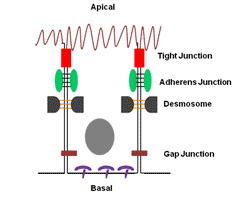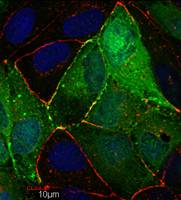Qualifications:
Ph.D: Indian Institute of Science, Bangalore
Areas of Interest/Specialization:
Regulation of Epithelial Tight Junctions
Experience:
Post-doctoral Experience: (i) University of Bath, United Kingdom;
(ii) University College London, United Kingdom.
Awards & Honours:
1). Ph.D. thesis awarded the C.V. Hanumantha Rao medal in the Faculty of Science, Indian Institute of Science, Bangalore, India.
Summary of Research :
Epithelial cells protect and enclose all our organs and line the body cavities. These cells form layers with tightly packed cells that are joined to each other by intercellular adhesive complexes that consist of tight junctions (TJ), adherens junctions (AJ), desmosomes (D) and gap junctions (GJ). Tight junctions are the most apical component of the epithelial adhesion complex and are composed of a complex protein network that is linked to the cytoskeleton. Tight junctions seal the passage between adjacent cells regulating the passage of ions and solutes through this paracellular space and contribute to the maintenance of cell polarity by helping to maintain distinct apical and baso-lateral domains in the plasma membrane. New evidence shows that TJs also regulate cell proliferation and differentiation. Consequently, breakdown or leakage through the TJ causes various diseases ranging from allergies to bacterial and viral diseases and even cancer. The tight junction complex also serves as an initial point of contact for several pathogens which have devised sophisticated strategies to disrupt the tight junction in order to infect host cells. The main focus of my laboratory is to investigate the mechanisms that regulate (i) how tight junctions are assembled, (ii) how TJs are maintained and (iii) how TJs break-down in various disease contexts. We are using a variety of approaches to address these questions with the ultimate aim of identifying TJ-based therapeutic strategies against diseases that occur as a result of TJ break-down or due to leakage through TJs.
(a) (b)
 
Figure shows (a) schematic representation of intercellular junctions and (b) MDCK cells expressing the enteropathogenic E.coli effector protein espF (green). Tight junctions are labeled with anti-occludin antibody (red).
Best Peer Reviewed Publications (upto 5):
-
Nie M, Aijaz S, Leefa Chong San IV, Balda MS, Matter K. (2009). The Y-box factor ZONAB/DbpA associates with GEF-H1/Lfc and mediates Rho- stimulated transcription. EMBO Reports, 10:1125-1131.
-
Aijaz S, Sanchez-Heras E, Balda MS, Matter K. (2007). Regulation of tight junction assembly and epithelial morphogenesis by the heat shock protein Apg-2. BMC Cell Biology, 8:49.
-
Aijaz S, Balda MS, Matter K. (2006) Tight junctions: Molecular architecture and function. International Reviews in Cytology; 248:261- 298.
-
Matter K, Aijaz S, Tsapara A, Balda MS. (2005) Mammalian tight junctions in the regulation of epithelial differentiation and proliferation. Current Opinion in Cell Biology; 17:453-458.
-
Aijaz S, D'Atri F, Citi S, Balda MS, Matter K. (2005). Binding of GEF-H1 to the tight junction-associated adaptor cingulin results in inhibition of Rho signalling and G1/S phase transition. Developmental Cell; 8:777-786.
Recent Peer Reviewed Journals/Books:
Book Chapter:
-
Saima Aijaz, Steven Goodrick, Karl Matter and Maria Balda (2006): 'Tight Junctions' in Encyclopedic Reference of Genomics and Proteomics in Molecular Medicine, Pages 1868-1873; Springer
Courses Offered:
CM610: Cell-Cell junctions: Biology & Diseases (3 credits):
Introduction to epithelial and endothelial junctional complexes; molecular composition, structure and function of tight junctions, adherens junctions, gap junctions and desmosomes; role in cell-cell adhesion; junctional diffusion barriers; regulation of paracellular permeability; signaling from the apical junctional complex and role in epithelial polarization, cell differentiation, proliferation and gene expression; junctional components targeted by disease causing micro-organisms; diseases associated with intercellular junctions including multiple sclerosis, type 1 diabetes, inflammatory bowel disease, and cancers of the breast, prostate and colon.
Number of Ph.D. students: 3
|